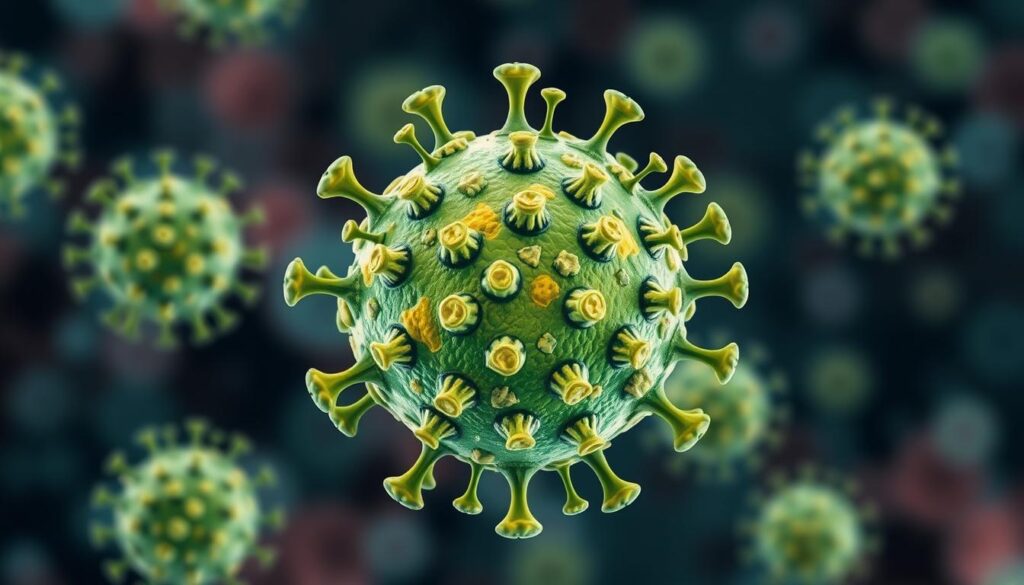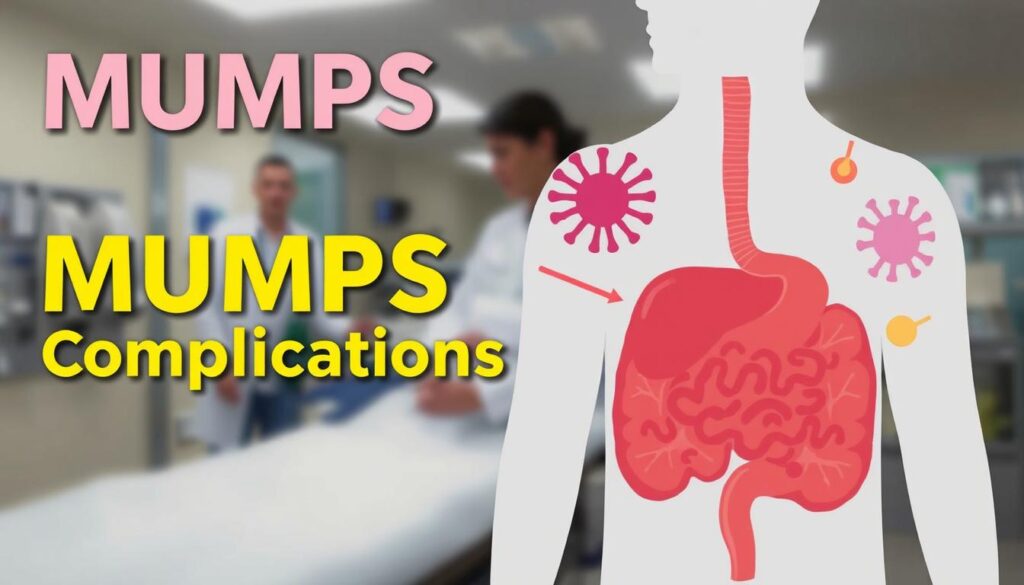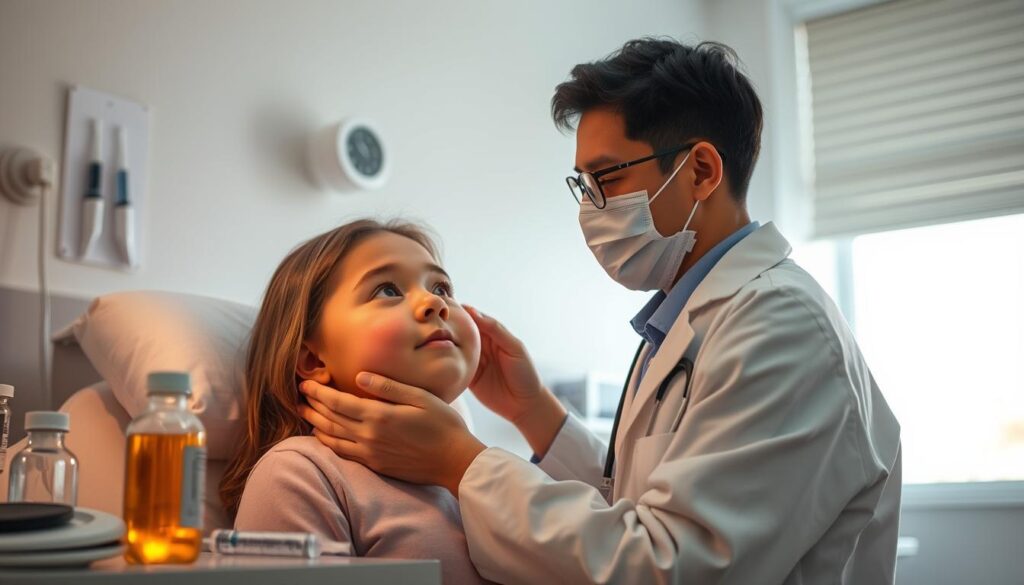Explore the key details on mumps, including its symptoms, how it spreads, and effective treatment approaches. Stay informed and healthy.
Mumps :This shows how important it is to know about the mumps virus. The virus attacks the salivary glands near the ears, causing swelling, fever, and headache. It’s key to understand mumps to prevent and treat it effectively.

Knowing about mumps is vital. It helps people avoid getting the disease. By learning about the mumps virus, its symptoms, and treatments, we can protect ourselves and our families.
Key Takeaways
- Understanding the causes and symptoms of mumps is crucial for effective prevention and treatment.
- The mumps virus is a highly contagious disease that affects the salivary glands near the ears.
- Mumps can lead to symptoms such as swelling, fever, and headache.
- Knowing about mumps can help individuals take preventive measures to avoid contracting the disease.
- Learning about the mumps virus and its treatment options can help people better protect themselves and their loved ones.
- Mumps is a significant public health concern, with 3,000 to 10,000 cases reported in the United States each year.
- Awareness about the mumps virus is essential for preventing its spread and reducing its impact on communities.
Understanding Mumps: An Overview
Mumps is a viral infection that affects the salivary glands. It causes mumps symptoms like swelling, pain, and fever. Knowing its history and global impact is key to understanding this disease.
Mumps was once a common childhood illness. But thanks to the mumps vaccine, cases have dropped a lot. Still, mumps symptoms can show up, especially where not many people are vaccinated. The World Health Organization (WHO) says mumps is still a big problem in many places.
What is the Mumps Virus?
The mumps virus is a contagious paramyxovirus. It spreads through droplets, contact with surfaces, and direct contact with someone who’s sick. Mumps symptoms usually start 16-18 days after you get infected and can be mild or severe.
Historical Background
Mumps has been written about for centuries. The first big outbreak was in the 5th century BC. Before the mumps vaccine came out in the 1960s, it was a big health worry.
Global Impact and Prevalence
The WHO says mumps still causes a lot of sickness and death in many countries. It’s a big problem in places where not many people get vaccinated. It can really hurt public health, especially where healthcare is hard to get.
It’s important to know about mumps’ history, global impact, and mumps symptoms. This helps us find better ways to prevent and treat it. By spotting the signs early, people can get help fast. This helps avoid serious problems and stops the virus from spreading.
Common Signs and Symptoms of Mumps
Mumps symptoms include swelling of the parotid glands near the ears. This swelling can be painful. It may also come with fever, headache, and muscle aches. People with mumps might feel tired and lose their appetite.
Some key mumps symptoms to watch for are:
- Swelling of the parotid glands
- Fever
- Headache
- Muscle aches
- Tiredness
- Loss of appetite
It’s important to know these symptoms to get medical help quickly. If you think you or someone else has mumps, see a doctor right away.
Knowing the common signs of mumps helps prevent its spread. It also ensures you get the right care if you’re affected.
How Mumps Spreads in Communities
Mumps is a highly contagious disease that spreads quickly in communities. This is especially true in areas with low vaccination rates. The contagious period starts a few days before symptoms appear and lasts up to five days after.
The main way mumps spreads is through respiratory droplets, like those from coughing or sneezing. Close contact, like sharing food or drinks, can also spread the disease. Knowing how mumps spreads is key to preventing outbreaks and controlling the disease.
Transmission Methods
- Respiratory droplets: Infected people can spread the virus through coughing or sneezing.
- Close contact: Sharing food, drinks, or utensils with an infected person can spread the disease.
- Contaminated surfaces: Touching surfaces contaminated with the virus and then touching one’s face can also spread the disease.
Incubation Period
The incubation period of mumps is about 16 to 18 days. It can range from 12 to 25 days.
Contagious Timeline
People with mumps are contagious from a few days before symptoms start until five days after. It’s important to take preventive measures like vaccination and good hygiene to reduce the risk of spreading the disease.
| Stage | Contagious Period |
|---|---|
| Before symptoms | 1-2 days |
| After symptoms appear | Up to 5 days |
Risk Factors and Susceptibility
Some people are more likely to get mumps because of certain factors. Age is a big one, especially for kids under 5. Also, those who haven’t had the MMR vaccine or have a weak immune system are at higher risk.
Health conditions can also make you more likely to face mumps complications like meningitis or encephalitis. Knowing these risks helps us take steps to avoid getting mumps.
Here are the main risk factors for mumps:
- Age: Children under 5 years old
- Vaccination status: Unvaccinated or partially vaccinated individuals
- Immune system: Weakened immune system due to certain health conditions
- Exposure: Close contact with someone who has mumps

Knowing these risks helps us take steps to prevent mumps. By understanding and acting on these factors, we can lower the chances of mumps and its serious side effects.
| Risk Factor | Description |
|---|---|
| Age | Children under 5 years old are more susceptible to mumps |
| Vaccination status | Unvaccinated or partially vaccinated individuals are at a higher risk |
| Immune system | Weakened immune system due to certain health conditions increases the risk of mumps complications |
Diagnosing Mumps: Medical Procedures
Diagnosing mumps requires physical exams, lab tests, and ruling out other diseases. Doctors use these steps to figure out if someone has mumps. They also decide on the best mumps treatment.
The first thing doctors do is a physical exam. They look for signs like swollen parotid glands. They also ask about the patient’s health history and symptoms.
Physical Examination
After the physical exam, doctors do lab tests to confirm the diagnosis. These tests might include blood tests or viral cultures.
Laboratory Tests
Sometimes, doctors need to rule out other diseases. This is called differential diagnosis. They compare symptoms and use lab tests to find the cause.
Differential Diagnosis
Common tests for mumps include:
- Enzyme-linked immunosorbent assay (ELISA)
- Hemagglutination inhibition (HAI) test
- Viral culture
These medical steps help doctors accurately diagnose mumps. They then create a good mumps treatment plan.
| Test | Description |
|---|---|
| ELISA | Measures the level of antibodies against the mumps virus |
| HAI test | Measures the level of antibodies against the mumps virus |
| Viral culture | Detects the presence of the mumps virus in a sample |
Treatment Options for Mumps
Mumps treatment aims to ease symptoms and aid the body’s healing. Rest and staying hydrated are key. They help the body fight off the infection.
Over-the-counter pain relievers can also help with fever and headache. But, it’s important to know that antiviral medications don’t work against the mumps virus.
Here are some common mumps treatment practices:
- Getting plenty of rest to help the body recover
- Staying hydrated by drinking plenty of fluids
- Using pain relievers to manage symptoms like fever and headache

It’s vital to listen to a healthcare professional’s advice on mumps treatment. They can guide you on the best treatment and manage any complications. By following these steps, you can ease your symptoms and help your body recover from mumps.
Potential Complications and Long-term Effects
Mumps can cause various complications, some serious and long-lasting. Mumps complications can affect different parts of the body. They can range from mild to severe.
Some people face a higher risk of mumps complications. Adults and those with weak immune systems are more likely to get sick.
Common Complications
- Orchitis, or inflammation of the testicles
- Meningitis, or inflammation of the lining around the brain and spinal cord
- Deafness, which can be temporary or permanent
Risk Groups
Adults and those with weak immune systems are at a higher risk. They are more likely to face mumps complications.
Long-term Health Impact
In some cases, mumps complications can affect health for a long time. This shows why prevention and quick treatment are key.
Prevention Through Vaccination
Vaccination is key in stopping mumps from spreading. The mumps vaccine is part of the measles, mumps, and rubella (MMR) vaccine. This vaccine works well to prevent mumps and its serious side effects.
The Centers for Disease Control and Prevention (CDC) says all kids should get the MMR vaccine. The first shot is given when they are 12-15 months old. The second shot comes when they are 4-6 years old. This mumps prevention has greatly lowered mumps cases in the U.S.
MMR Vaccine Details
The MMR vaccine is a live, weakened version of the measles, mumps, and rubella viruses. It’s given as an injection, usually in the arm or leg.
Vaccination Schedule
The MMR vaccine schedule is clear:
- First dose: 12-15 months of age
- Second dose: 4-6 years of age
Vaccine Effectiveness
The MMR vaccine is very effective. It has an 88% success rate after one dose and 95% after two doses.
| Vaccine | Effectiveness |
|---|---|
| MMR Vaccine (1 dose) | 88% |
| MMR Vaccine (2 doses) | 95% |
Managing Mumps Outbreaks
Handling a mumps outbreak needs a team effort. This includes public health actions, spreading the word, and working together. The aim is to stop the outbreak and lessen its effects on everyone.
Here are some ways to tackle mumps outbreaks:
- Find and keep apart those who are sick
- Start vaccination efforts to stop more cases
- Teach the community how to prevent and control mumps outbreaks
It’s key to have everyone’s help in fighting mumps outbreaks. When we all work together, we can stop the disease from spreading. This helps keep our community safe.
Knowing how to manage mumps outbreaks is vital. By using the right strategies, we can lower the risk of getting sick. This protects our health as a whole.
| Strategy | Description |
|---|---|
| Public Health Interventions | Starting vaccination programs, isolating sick people, and spreading awareness |
| Community Awareness | Sharing info and resources on mumps outbreak prevention and control |
| Cooperation | Working together with health experts, doctors, and community members to handle the outbreak |
When to Seek Medical Attention
It’s important to know when to see a doctor if you have mumps symptoms. Look out for swelling in the parotid glands, fever, or headache. These signs mean you should talk to a healthcare provider. Mumps is mumps contagious, so it’s key to stop it from spreading.
In serious cases, mumps symptoms need quick medical help. Watch for severe headache, stiff neck, or trouble breathing. If you see these signs, get medical help fast.
Emergency Warning Signs
- Severe headache
- Stiff neck
- Difficulty breathing
- High fever
Doctors are key in handling mumps contagious cases. They can tell you how to stop it from spreading and help with symptoms. If you’re worried about mumps symptoms or have been near someone with it, see a doctor.
Conclusion: Taking Control of Mumps Prevention
Mumps is a contagious viral disease that can lead to serious issues if not handled. By taking steps to prevent it, we can help control outbreaks. The mumps vaccine is key in mumps prevention, lowering the risk of getting the virus and its complications.
This guide has covered mumps symptoms, causes, and treatments. It’s also shown the importance of vaccination and knowing when to seek medical help. By staying informed and taking precautions, we can protect our health and that of our community.
Prevention is the best way to fight mumps. Encourage your loved ones and community to get the MMR vaccine and watch for mumps signs. Working together, we can make mumps a rare disease, focusing on everyone’s health and well-being.
FAQ
Q: What is the Mumps Virus?
A: The mumps virus is a contagious RNA virus. It mainly affects the parotid salivary glands, causing them to swell. It can lead to symptoms like fever, headache, and muscle aches.
Q: What are the common symptoms of Mumps?
A: Swelling of the parotid glands is the main symptom of mumps. It usually happens on one or both sides of the face. Other symptoms include fever, headache, muscle aches, fatigue, and loss of appetite.
Q: How does Mumps spread?
A: Mumps spreads through direct contact with respiratory droplets or saliva from an infected person. It can also spread through contact with contaminated surfaces or sharing personal items. The virus’s incubation period is 16-18 days. An infected person can spread the virus for several days before and after symptoms start.
Q: Who is most at risk of Mumps?
A: People who are unvaccinated, haven’t had mumps before, or have weakened immune systems are at high risk. Mumps can affect anyone, but it’s most common in children and young adults.
Q: How is Mumps diagnosed?
A: Doctors diagnose mumps through a physical exam and lab tests. Tests include blood tests or tests for the virus in saliva or respiratory secretions. They also rule out other conditions with similar symptoms.
Q: What are the treatment options for Mumps?
A: There’s no specific treatment for mumps. Treatment focuses on managing symptoms and supporting recovery. This includes rest, hydration, over-the-counter pain meds, and sometimes medications for swelling or fever.
Q: What are the potential complications of Mumps?
A: Complications of mumps include orchitis, meningitis, encephalitis, pancreatitis, and hearing loss. These are more common in adults and can have serious long-term effects if not managed properly.
Q: How can Mumps be prevented?
A: Preventing mumps is best done through vaccination with the measles-mumps-rubella (MMR) vaccine. The MMR vaccine is given in two doses. The first dose is recommended between 12-15 months of age, and the second between 4-6 years of age.
Q: When should someone seek medical attention for Mumps?
A: Seek medical attention if you think you have mumps. Early diagnosis and treatment can prevent the virus’s spread and reduce complications. Seek emergency help for severe headache, stiff neck, or trouble breathing.
